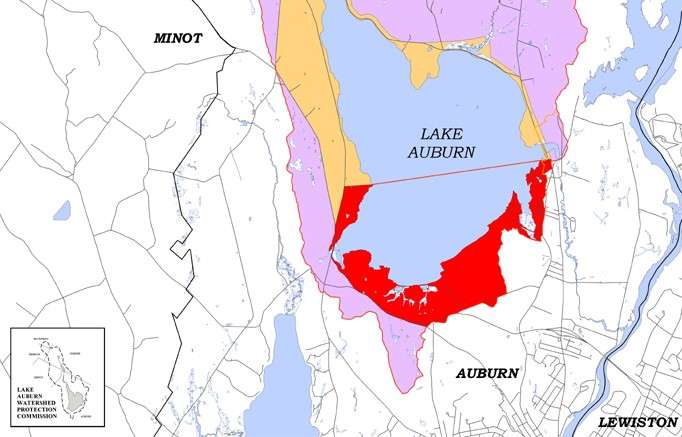
Processing Your Payment
Please do not leave this page until complete. This can take a few moments.
- News
-
Editions
View Digital Editions
Biweekly Issues
- December 1, 2025
- Nov. 17, 2025
- November 03, 2025
- October 20, 2025
- October 6, 2025
- September 22, 2025
- + More
Special Editions
- Lists
- Viewpoints
-
Our Events
Event Info
Award Honorees
- Calendar
- Biz Marketplace
Lake Auburn development will be a balancing act, study finds
 Courtesy / FB Environmental
A new study says that some swimming and limited development could be possible on Lake Auburn, which is the water supply for the Lewiston-Auburn area. Here the lake is treated with alum to keep the phosphorus levels low.
Courtesy / FB Environmental
A new study says that some swimming and limited development could be possible on Lake Auburn, which is the water supply for the Lewiston-Auburn area. Here the lake is treated with alum to keep the phosphorus levels low.
A study has determined that low-impact use of Lake Auburn, which is the water supply for the Lewiston-Auburn area, would not cause significant harm and would provide some economic benefit. But the gap between harm and benefit tightens the more development is allowed.
A city-commissioned study by Portland-based FB Environmental, the Horsley Witten Group and University of Maine looked at the environmental and economic impact of lifting restrictions on the 2,260-acre lake. Lake restrictions have been a long-standing frustration of many of the city's development proponents.
The initial takeaway is that while some uses, like restricted swimming, could be allowed, the more use and development there is the more it will cost to keep the lake clean. Benefits from increased property taxes and other economic impact also decline as development increases.
The study looked at environmental changes and regulations of the past, as well as what can be done "to set the stage for considering economic trade offs," Rich Brereton of FB Environmental old the city council on June 22. The expected results of climate change were factored into the study, Brereton said, but he cautioned that it's difficult to predict what those effects will be.
Development around the southern half of the lake is prohibited, as is any water-related activity, including swimming and boating. The rest of the lake is less restricted, but swimming and development is prohibited. To keep phosphorous levels low, the lake is treated with alum, most recently in 2019.
The study measured the levels of phosphorus, which is a contaminant that causes algae and cyanobacteria growth. In the “business as usual” model — if current regulations didn't change — phosphorus would climb to nearly 10 parts per billion by the year 2100, even if it's treated with alum at regular intervals. That level, similar to where it was in 2018 before the lake was treated, results in complaints of odor and bad taste from water users and 40% algae blooms, which can choke out lake life.
The “maximum development” model, where development codes are loosened, pushes the lake to a level where there are twice the algae blooms of the "business as usual" scenario by 2100, despite regular alum treatments. The levels would result in frequent issues with water taste and odor and a lower economic benefit from recreation. That model would likely require a filtration plant, Brereton said.
"The most important drivers of high phosphorus loads were the number of new buildings, and the amount of agriculture (row crops and livestock)," a summary of the report said. "Tax revenue increases from development were roughly offset by the additional costs of treatment in the 'maximum development' scenario."

Jump in, the water's fine
While further discussion of the study is planned, the initial takeaway is that swimming, with some restrictions, can be allowed, which city officials said will be an economic boost.
The difference between allowing boating as opposed to swimming, is the difference in the way machines and humans cause contamination. Petroleum products like gas and oil float on the surface and evaporate quickly, while the bacteria and viruses humans carry "are much more evasive and persistent, and therefore much more likely to cause potential contamination," according to the Lake Auburn Watershed Protection Commission.
“For years, we’ve wondered why we can’t swim or fully recreate in Lake Auburn,” Auburn Mayor Jason Levesque said in a news release following the FB Environmental presentation. “Now we can see that we can without negative harm to our great lake. This is the beginning of a new era for Auburn.”
The report recommends swimming be restricted, including things like limiting beach access to city residents, limiting swimming capacity to 50 people at any one time, roping off the swimming area with buoys, using paid access stickers to help offset monitoring costs and prohibiting swimming from boats.
Levesque said that the study means the city can allow changes that will "have a significant, positive impact for all of our residents in the form of lower taxes, more recreational opportunities and a better natural environment.“
“We have an incredible natural resource that we can protect and enjoy in a ecologically sensitive and responsible way," Levesque said in a news release after the council heard the FB Environmental presentation.
The city is in the process of updating its comprehensive plan and will include conclusions from the watershed study in the Future Land Use chapter.
Mainebiz web partners
Honestly, as an out of state developer, I hate to do it, but I’d buy up the entire offering and develop it in a heartbeat. If I don’t, someone else will now that it will no longer be protected.

The Giving Guide
The Giving Guide helps nonprofits have the opportunity to showcase and differentiate their organizations so that businesses better understand how they can contribute to a nonprofit’s mission and work.
Learn More
Work for ME
Work for ME is a workforce development tool to help Maine’s employers target Maine’s emerging workforce. Work for ME highlights each industry, its impact on Maine’s economy, the jobs available to entry-level workers, the training and education needed to get a career started.
Learn More
Groundbreaking Maine
Whether you’re a developer, financer, architect, or industry enthusiast, Groundbreaking Maine is crafted to be your go-to source for valuable insights in Maine’s real estate and construction community.
Learn more-
The Giving Guide
The Giving Guide helps nonprofits have the opportunity to showcase and differentiate their organizations so that businesses better understand how they can contribute to a nonprofit’s mission and work.
-
Work for ME
Work for ME is a workforce development tool to help Maine’s employers target Maine’s emerging workforce. Work for ME highlights each industry, its impact on Maine’s economy, the jobs available to entry-level workers, the training and education needed to get a career started.
-
Groundbreaking Maine
Whether you’re a developer, financer, architect, or industry enthusiast, Groundbreaking Maine is crafted to be your go-to source for valuable insights in Maine’s real estate and construction community.
ABOUT
NEW ENGLAND BUSINESS MEDIA SITES
No articles left
Get access now
In order to use this feature, we need some information from you. You can also login or register for a free account.
By clicking submit you are agreeing to our cookie usage and Privacy Policy
Already have an account? Login
Already have an account? Login
Want to create an account? Register
Get access now
In order to use this feature, we need some information from you. You can also login or register for a free account.
By clicking submit you are agreeing to our cookie usage and Privacy Policy
Already have an account? Login
Already have an account? Login
Want to create an account? Register







1 Comments